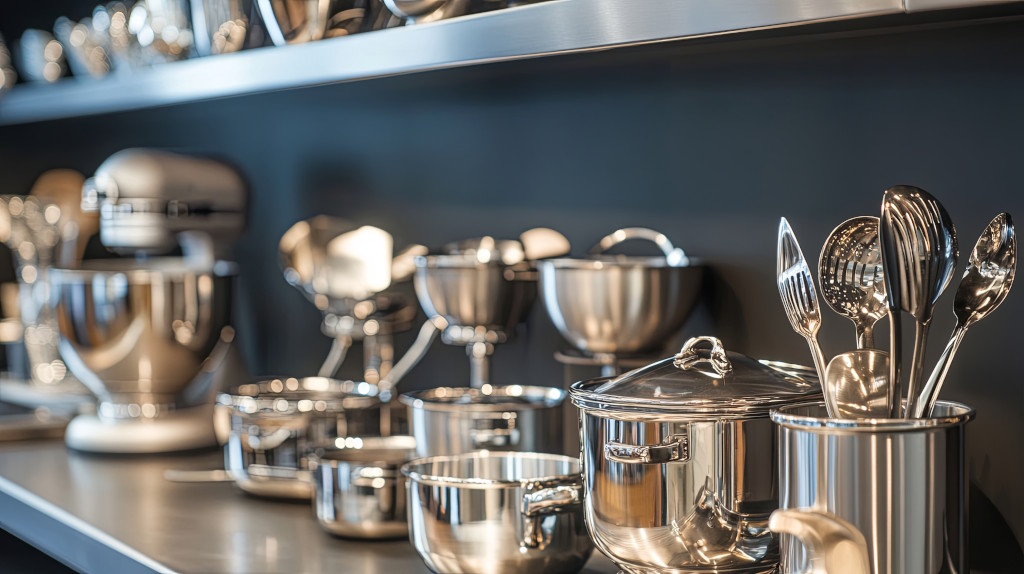
Stainless steel is an intrinsically safe and environmentally responsible choice for cookware. Photo: Dreamstime
As awareness grows around the health and environmental impacts of everyday materials, stainless steel is emerging as a safer, more sustainable choice—especially in kitchens. Tim Collins, Secretary General of the World Stainless Association, makes the case for replacing plastic and coated cookware with stainless steel, drawing on new research into microplastics, recycled materials, and hygiene. This article explores why stainless steel isn’t just durable—it’s essential for the future of safe food preparation.
By Joanne McIntyre, Stainless Steel World
Stainless steel already plays a vital role in the home kitchen, but its application should extend far beyond sinks and frying pans. According to Tim, its adoption as a replacement for plastic kitchen items is both logical and necessary – for the sake of human health. “Cookware is a major global industry, valued at over USD 31 billion annually for domestic applications alone. That figure doesn’t even account for the myriad small kitchen utensils we use daily,” Tim notes. “When we consider the full spectrum of kitchen products, the market is substantially larger.”
In recent years, academic research has raised serious concerns about the materials commonly used in kitchenware. Many of these materials—especially plastics and certain ceramic coatings—have been shown to pose health risks. The origins of these products trace back as far as 1955, coinciding with the rise of the throwaway culture. For more than three generations, consumers have used items presumed to be safe, simply because they were convenient and affordable. However, growing scientific understanding is painting a different picture.
Microplastics: a growing threat
If concerns about plastics still seem overstated, recent findings may offer a sobering perspective. In February 2025, researchers at the University of New Mexico Health Sciences reported detecting microplastics in human brain tissue at significantly higher concentrations than in other organs. Even more concerning, the accumulation rate has increased by 50% in just the past eight years.
“These microplastics don’t disappear,” Tim explains. “They accumulate over time. Studies, including several from the University of Colorado, have demonstrated that microplastics can cross the blood-brain barrier in under 30 minutes. The implications for long-term health are profound.”
The stainless steel solution
As awareness of this issue grows, so too must our response. At worldstainless, proactive steps are already underway. In June, a new Research Fellow will begin a 12-month project to systematically review academic literature, consolidate key findings, and develop a comprehensive public awareness campaign. This initiative will include case studies and scientifically grounded materials to inform consumers and industry professionals alike.
“While microplastics and material safety are trending topics on social media, we believe the conversation needs a more structured, evidence-based approach,” Tim says.
The guiding principle is clear: durability, safety, and hygiene must be prioritized. Stainless steel exemplifies these attributes. It is non-reactive, corrosion-resistant, and long-lasting – ideal for applications where material integrity is critical.
“We need to move away from a culture of disposability,” Tim concludes. “Stainless steel offers a sustainable, health-conscious alternative. It’s time to rethink our assumptions and make informed, responsible choices for the future.”
Hidden risks of recycled plastics in food environments
While stainless steel is the material of choice in most industrial kitchens, Tim highlights that many foods—particularly those processed in factory environments—still encounter plastics at various stages of production.
“Materials such as high-density polyethylene are commonly used in food conveyor systems,” Tim explains. “On first use, these materials can be compliant and safe. However, once recycled, their integrity changes. I would argue that it is fundamentally unsafe to use recycled plastics for food preparation or containment.
With recycling, not only do we see the release of microplastics, but also the leaching of chemical additives such as plasticisers, stabilisers, and other compounds introduced during manufacturing to enhance flexibility and reusability.
This concern isn’t rooted in anti-plastic sentiment, but rather in science-based hygiene and safety.
“I’m not anti-plastic,” says Tim, “but I am pro-hygiene. If microplastics are accumulating in our bodies, we must prioritise food-contact materials that do not shed particles or leach harmful substances into our food.”

Stainless products are a safer option for industrial food preparation. Photo: Dreamstime
Rethinking common kitchen choices
Although many households already rely on stainless steel cookware, there remains a tendency to pair stainless with non-stick coatings, particularly in frying pans. Tim warns that these coatings—often Teflon-based—carry their own risks.
“Teflon coatings can release fumes that cause a condition known as ‘Teflon Flu,’ or polymer fume fever,” he notes. “This might be less concerning for most humans, but animals—especially birds and small mammals—are highly susceptible due to their fast respiratory systems. If you have pets at home, you could be unknowingly exposing them to serious health risks.”
Instead, Tim advocates a more holistic view when selecting kitchen materials. While stainless steel may come at a higher upfront cost, it delivers unmatched value over the long term.
“Think of it as a smart investment. Stainless isn’t just the hygienic and durable option, it’s the choice that protects your family, reduces long-term costs, and aligns with a more responsible, sustainable way of living.”
Why stainless steel is hygienic by nature
The hygienic properties of stainless steel are not incidental—they’re rooted in its metallurgical structure. Tim offers an explanation:
“Stainless is classified as a passive film material, meaning it develops an invisible oxide layer on its surface when exposed to oxygen. Because oxygen is also present in water and other liquids, the passive film naturally forms and regenerates even in wet environments.” In the case of stainless steel, this protective layer is primarily made of chromium oxide, derived from its minimum 10.5% chromium content. This passive film not only prevents corrosion, but it also ensures a smooth, crevice-free surface where bacteria cannot take hold. “If the surface is scratched or abraded, the film self-repairs in the presence of oxygen. That’s what makes stainless so uniquely hygienic. Very few materials possess these characteristics. It’s non-toxic, non-reactive, and fully recyclable.” In fact, more than 96% of end-of-life stainless steel is recycled into new stainless steel products—making it one of the most sustainable engineering materials available today.
“Stainless steel is, in many ways, a near-utopian material,” says Tim. “It checks every box: safety, durability, sustainability, aesthetics. I firmly believe it’s worth investing in high-quality stainless cookware. It will last a lifetime, retain its visual appeal, and help move us towards a more health-conscious and environmentally responsible society.”
About Tim Collins
 After graduating with an honours degree in Metallurgy, Tim joined the graduate program of British Steel Stainless in the early 1980s. He held roles in the Hot Rolled Plate Division of Avesta Sheffield, which merged with Outokumpu Oyj to form AvestaPolarit in 2001. After the company was rebranded as Outokumpu in 2004, Tim was appointed Supply Chain General Manager for Long Products. Tim joined the Board of the British Stainless Steel Association and was Chairman between 2017 and 2019. Tim took up his current position of Secretary-General of worldstainless (formerly the International Stainless Steel Forum) in 2019. He is also a member of the Steering Committee for the Duplex World conference.
After graduating with an honours degree in Metallurgy, Tim joined the graduate program of British Steel Stainless in the early 1980s. He held roles in the Hot Rolled Plate Division of Avesta Sheffield, which merged with Outokumpu Oyj to form AvestaPolarit in 2001. After the company was rebranded as Outokumpu in 2004, Tim was appointed Supply Chain General Manager for Long Products. Tim joined the Board of the British Stainless Steel Association and was Chairman between 2017 and 2019. Tim took up his current position of Secretary-General of worldstainless (formerly the International Stainless Steel Forum) in 2019. He is also a member of the Steering Committee for the Duplex World conference.
About this Tech Article
Appearing in the June 2025 issue of Stainless Steel World Magazine, this technical article is just one of many insightful articles we publish. Subscribe today to receive 10 issues a year, available monthly in print and digital formats. – SUBSCRIPTIONS TO OUR DIGITAL VERSION ARE NOW FREE.
Every week we share a new technical articles with our Stainless Steel community. Join us and let’s share your technical articles on Stainless Steel World online and in print.

